
An unarmed Minuteman III intercontinental ballistic missile launches during an operational test on April 26, 2019, from Vandenberg Air Force Base, California. US Air Force photo by Senior Airman Ian Dudley via DVIDS.
The two-lane road stretches straight across the empty Wyoming plains. There’s not a tree in sight to interrupt the rolling, grass-covered expanse. We’re smack in the middle of America’s vast interior and heading toward the front lines of a new era in global, great-power competition.
We continue on, and up ahead off the road I observe what looks like a single-story, ranch-style home. This is Missile Alert Facility Alfa-01, which commands 10 nuclear-armed Minuteman III intercontinental ballistic missiles located at separate launch sites scattered across the countryside. Apart from some unusual antennas and a barbed-wire-topped metal fence, there’s nothing about this building’s appearance that outwardly betrays its true identity.

Inside the wire at Missile Alert Facility Alfa-01, which commands 10 nuclear-armed Minuteman III intercontinental ballistic missiles. Photo by Nolan Peterson/Coffee or Die Magazine.
Operational since 1964, the Alfa-01 alert facility is not a relic of some bygone era. You’d never know it based on exterior clues, but buried about 60 feet underground is the facility’s launch control center, where two missile combat crew members are always ready within minutes to launch a nuclear strike against targets on the other side of the world. More than three decades after the Soviet Union’s collapse and the end of the Cold War, America’s operational arsenal of some 400 nuclear-tipped, land-based ICBMs remains on alert 24 hours a day, 365 days a year.
On this day, I’m riding in a government truck along with several Air Force Global Strike Command escorts. We turn off the public two-lane road and advance toward Alfa-01’s front gate. Our driver phones someone, and a moment later the gate opens. We park and walk past a group of Air Force personnel from the 319th Strategic Missile Squadron, based out of Francis E. Warren Air Force Base in Wyoming. They’ve just completed their weeklong shift at this lonely site and look happy to be going home.
We enter the building and pass through a security checkpoint on the way to a common living room furnished with couches, a flat-screen TV, and a pool table. Farther on, there’s a fully stocked kitchen and multiple dorm-style bedrooms. A grocery list is scribbled on a whiteboard in the dining area. (Food deliveries come twice a week.) Framed paintings of bald eagles and iconic American landscapes decorate the walls.

The approach to Missile Alert Facility Alfa-01, which commands 10 nuclear-armed Minuteman III intercontinental ballistic missiles. Photo by Nolan Peterson/Coffee or Die Magazine.
After a quick briefing, we enter a secure area and load into an elevator. An Air Force officer closes the double folding shutter metal doors, and we begin to descend.
Through the metal shutters I watch as the elevator shaft slowly passes by — murals dating back decades cover the concrete wall. One painting shows the moon with an American flag on it. At the bottom, our escort exits the elevator and spins a couple of knobs on a blast door. When the metal barrier swings open, I observe that it is at least 2 feet thick. Across the threshold, 1st Lt. Cory Sylvester stands waiting. Clad in a green flight suit, the 25-year-old is one of the two missile combat crew members, colloquially known as missileers, on 24-hour alert duty this day.
“Just another day in the life,” he says.
A More Complicated World
Headquartered at Barksdale Air Force Base in Louisiana, US Air Force Global Strike Command is in charge of America’s nuclear-armed, land-based ICBMs, as well as the nation’s fleet of nuclear-capable strategic bombers — two legs of the so-called nuclear triad, which also includes the US Navy’s submarine-based missiles.
America has never gone to war against a nuclear-armed adversary. And during the past two decades of counterinsurgency operations in places such as Iraq and Afghanistan, America’s aging nuclear deterrent may have, at times, seemed like an outdated carryover from an earlier era. In fact, many of Global Strike Command’s weapons systems date back to the Cold War. The B-52 strategic bomber first flew in 1952. The Minuteman III, America’s only operational land-based ICBM, first entered service around 1970.
During the Cold War, the Air Force’s Strategic Air Command was responsible for America’s nuclear bombers and land-based missiles. Air Force Global Strike Command has taken over those responsibilities, yet it is no carbon copy of Curtis LeMay’s SAC. Even if the weapons systems haven’t changed much, the times certainly have. After Russia’s full-scale invasion of Ukraine this February, and as tensions mount with China over the fate of Taiwan, the US homeland is increasingly enmeshed within a global threat environment more complicated than the Cold War ever was.
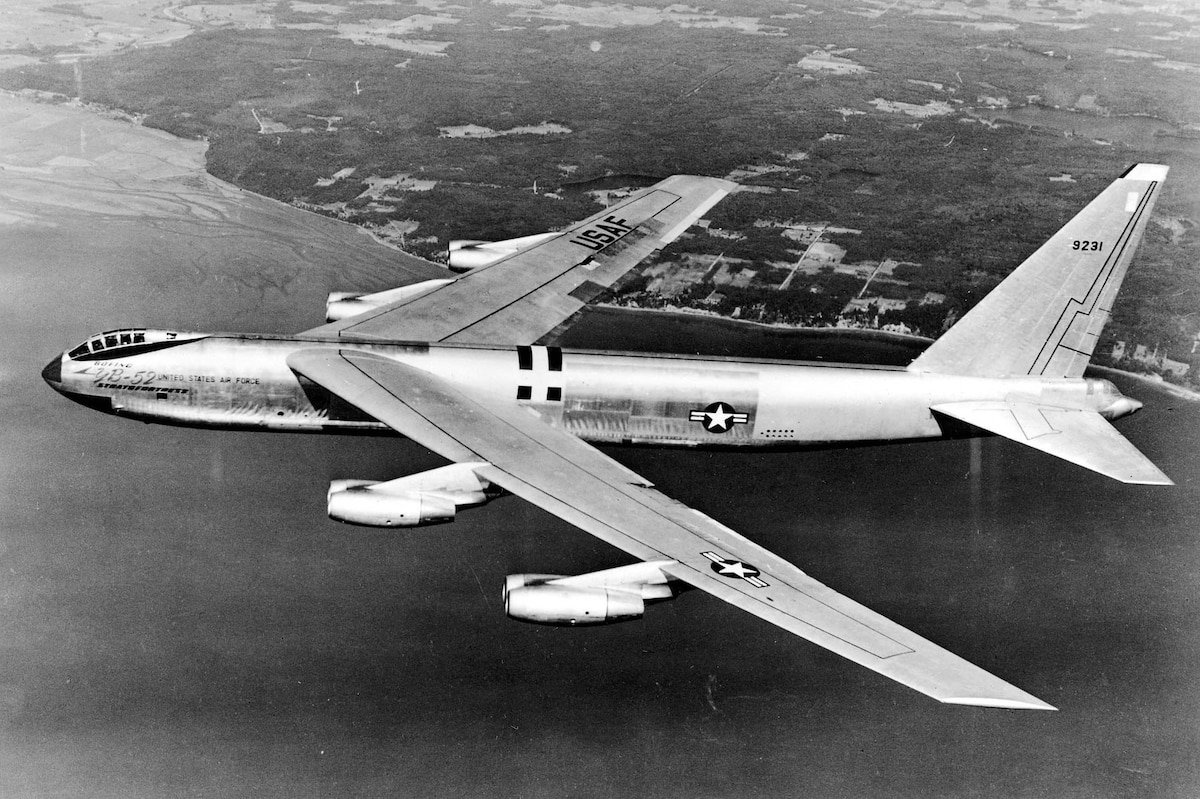
The first flight of the YB-52, the B-52 bomber's prototype, on April 15, 1952. US Air Force photo.
Strategic deterrence is “more challenging” in a multipolar world, says Maj. Gen. Michael Lutton, commander of Air Force Global Strike Command’s 20th Air Force, which is responsible for America’s ground-based ICBMs. Unlike bipolar Cold War competition with the Soviet Union, the US homeland now faces strategic threats from Russia and China, as well as from rogue nations such as North Korea.
“There’s not this monolith of the Soviet Union, which is primarily, almost exclusively, what Strategic Air Command was designed to confront,” Lutton tells me during an interview in his office at Francis E. Warren Air Force Base. “You have many more actors on the stage, if you will, that as a nation we have to look at. As a military […] we take all those contingencies and all those variabilities into account.”
During the Cold War, America’s nuclear deterrence plan was crafted to address the mindsets of Soviet leaders. To that end, US military planners leaned heavily on a crop of analysts dedicated to understanding the Soviet way of thinking, explains Lutton, who began his military career in Strategic Air Command at the tail end of the Cold War.
“Now, we’ve got all these other actors,” Lutton says. “So, from that standpoint, there’s a complexity to it. It’s clearly not insurmountable, but in my opinion it’s more complex [than during the Cold War].”

Soviet intercontinental ballistic missiles, designed to carry nuclear weapons, on display in the Ukrainian city of Dnipro. Photo by Nolan Peterson/Coffee or Die Magazine.
In a multipolar world, there is no single deterrence theory that can address the different cultures and societal norms of nuclear-armed states such as Russia, China, and North Korea. Each of these countries possesses unique reasons for acquiring and maintaining nuclear weapons, and they leverage the nuclear threat in different ways. Consequently, the Cold War-era strategies America used to deter and defend against the Soviet threat — including concepts such as mutually assured destruction, or MAD — may not always be useful.
“There’s a high premium on understanding cultures, understanding societies,” Lutton says. “Without that firsthand understanding of those societies and those cultures, when you go to the [nuclear] deterrence business, one can’t really understand decision-making and decision calculus unless you really understand those cultures.”
Compounding the complexity of contemporary nuclear deterrence, new technologies such as hypersonic missiles are more difficult to track and destroy than Cold War-era ICBMs and bombers. Moreover, America’s modern adversaries may not necessarily begin a nuclear war with an apocalyptic exchange of multi-megaton, city-destroying hydrogen bombs.
Both China and Russia have developed tactical nuclear weapons designed to destroy discrete military units and facilities, rather than whole cities. Thus, a nuclear exchange comprising these smaller-yield weapons may not result in the complete annihilation of both camps. Ironically, some experts warn that the glamour of a “winnable” nuclear war may actually increase the risk that nuclear weapons are used. Even so, there is practically no way to cripple America’s dispersed nuclear force with one “bolt out of the blue” nuclear strike, Lutton says.
“We deliver peace by setting that bar high for a potential adversary,” he adds. “And we also give potential adversaries pause.”
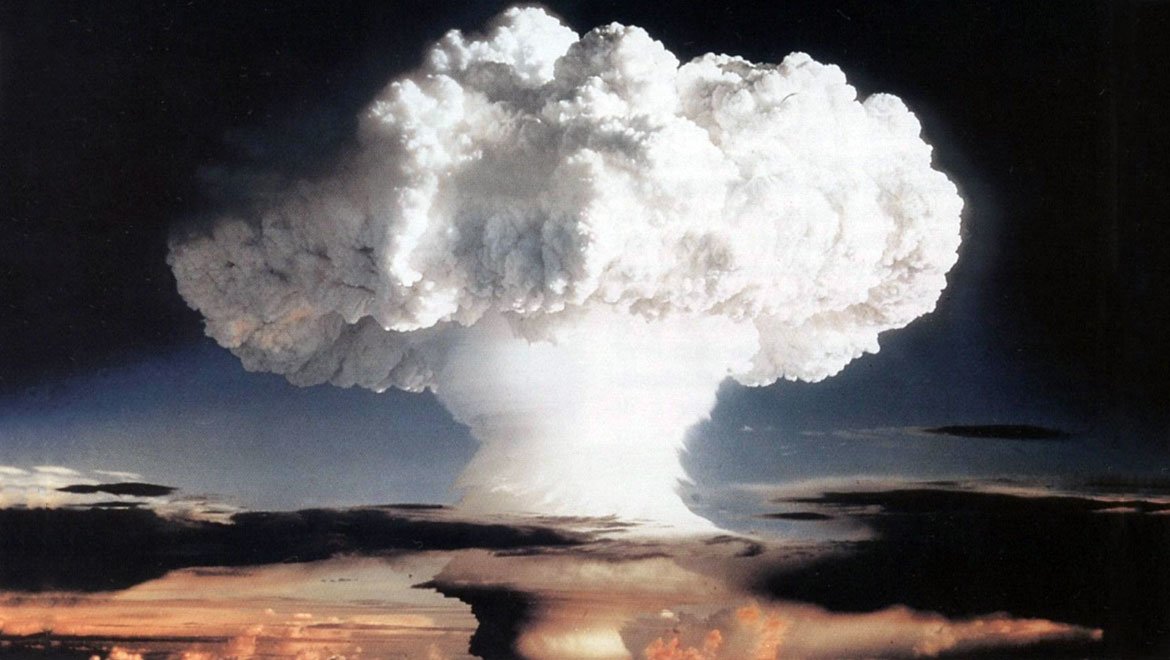
Ivy Mike (yield 10.4 megatons) — an atmospheric nuclear test conducted by the US at Enewetak Atoll on Nov. 1, 1952. It was the world's first successful hydrogen bomb. US Department of Defense photo.
‘Is This How the World Ends?’
After introductions and a quick safety briefing, Sylvester leads the way through a narrow passageway that exits into a cavernous room, at the center of which is a metal structure known as the “capsule.” About the size and shape of a Conex cargo container, the capsule is attached to the enveloping walls by pneumatic shock absorbers.
Should a nuclear weapon strike nearby, the shock absorbers are meant to prevent vibrations from killing or incapacitating the pair of missileers inside the capsule. Second Lt. Dillon Berg, the other missileer on alert duty this day, shines a flashlight on one of the shock absorbers and tells me, “There’s a lot of survivability in the capsule. We are theoretically supposed to be able to absorb the shock [of a nuclear blast] and remain alive.”
In addition to backup generators and valves to seal off radioactive air from entering, Berg adds that the underground facility is equipped with enough food (a cache of meals ready to eat) to keep the two missileers alive “for months.”
“We plan for everything that could happen,” Berg says. “We’ll stay in the fight.”
Inside the capsule, six separate communications systems fill one of the long walls. In addition to satellite and radio communications, some messages to the capsule travel through commercial telephone lines. While we talk, the two missileers field a near-constant stream of phone calls. Several times I have to step outside when a classified message comes through. It’s just an ordinary hour of an ordinary day, but the place brims with activity.
The other long wall inside the capsule comprises two workstations, one for each missileer. The two seats are thickly padded and set on a railing system. Equipped with heavy-duty harnesses, the seats are designed to protect against the shock of a nuclear explosion. Most of the electronics are Cold War-era vintage: lots of knobs, switches, and illuminated buttons. Three-ring binders fill bookcases above the workspaces.
Sylvester points out the launch switches — a 45-degree twist to the right and the knob turns to the “launch” position. I stare at the switch and can’t help but wonder, Is this how the world ends?
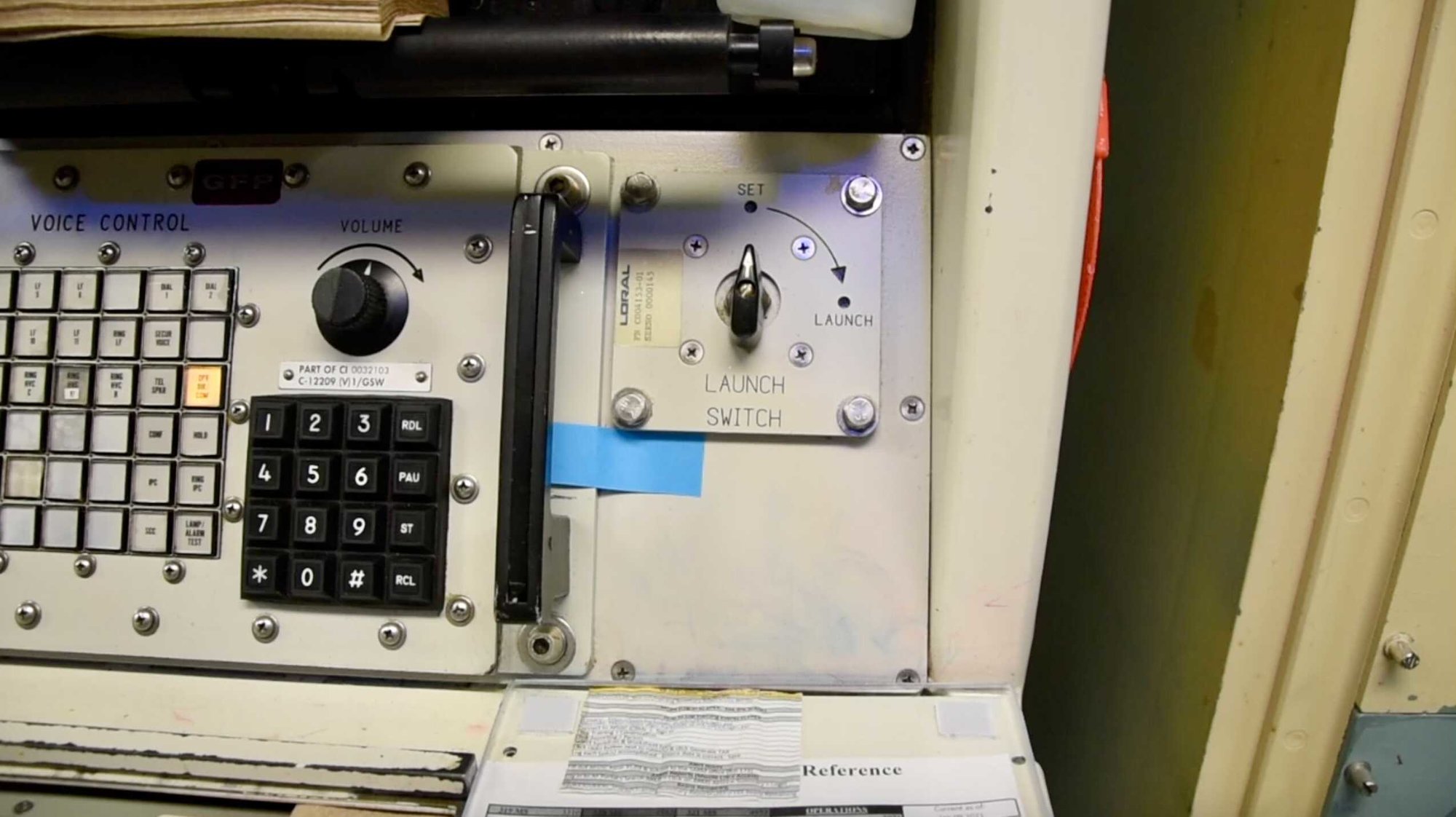
A launch switch inside the underground launch control center at Missile Alert Facility Alfa-01. Photo by Nolan Peterson/Coffee or Die Magazine.
The ‘Why’
The capsule may be aged, but the threats it’s meant to deter are modern and urgent. Berg, for his part, says that the updates he receives from his squadron’s intelligence personnel regarding America’s adversaries “make me feel relevant in my job.”
“Without those intel briefs that we are provided by our intel people, we would have no idea about the ‘why’ behind what we do,” Berg says. “Understanding the ‘why’ is huge. It keeps us going, it keeps our gears turning.”
Traveling at about 15,000 mph, a Minuteman III can hit its target on the other side of the globe in about 30 minutes. The ICBMs are not permanently mated to predetermined targets, and missileers are able to rapidly target their missiles — an important attribute in a world of multiple, nuclear-armed competitors. “If a threat were to pop up out of the blue, and we need that threat covered, we have the capability to do that very fast,” Sylvester says.
Two people are required to launch an American ICBM. Although the exact launch timeline is classified, the whole process takes place "in a matter of minutes,” Sylvester explains.
“In the event that we receive an authentic and valid emergency action message from the president of the United States, through any one of our numerous [communication] systems […] we’ll process it in accordance with our documents,” Sylvester says.
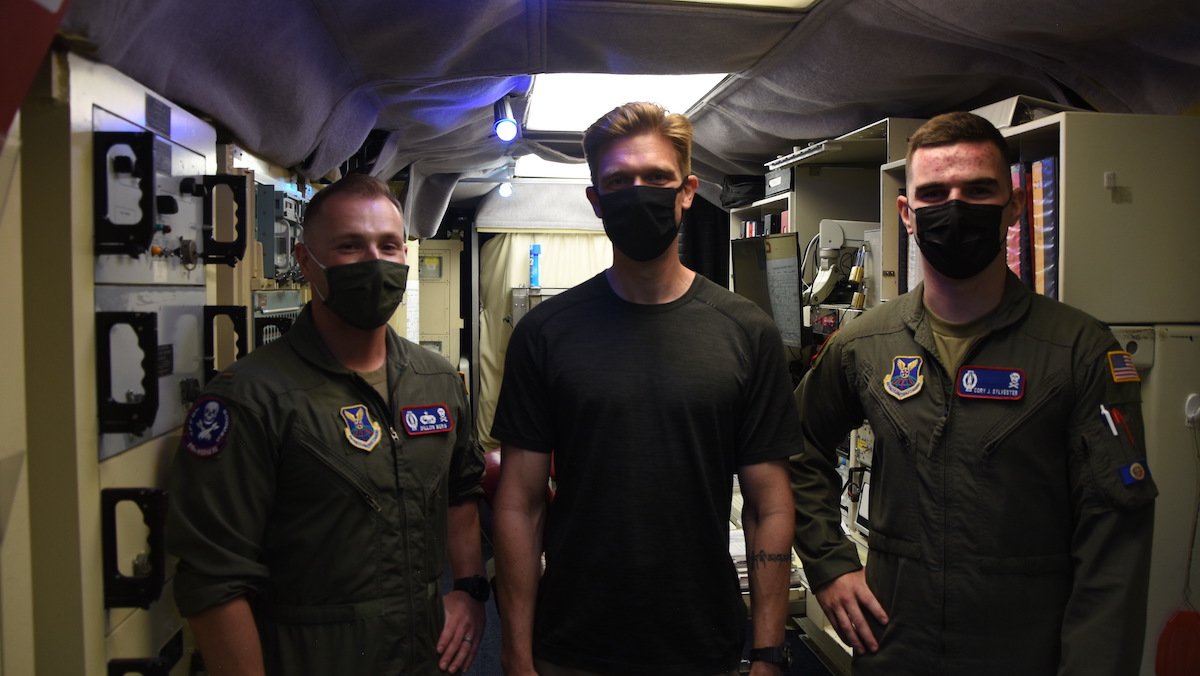
The author, center, inside Alfa-01's underground launch control center alongside 2nd Lt. Dillon Berg, left, and 1st Lt. Cory Sylvester. Photo courtesy of Nolan Peterson/Coffee or Die Magazine.
Once the presidential launch order is authenticated and some other checklist steps are completed, the missileers turn a switch to “enable” the 10 missiles they control. Then they remove four launch keys from a double-padlocked container. In unison, each missileer turns two keys. And that’s that.
Dating back to the 1960s, these strict launch protocols ensure that missiles aren’t accidentally launched, and if purposefully launched that they go where they’re supposed to — foundational command and control concepts known as “nuclear surety” and “positive control,” respectively.
“The procedures that we have in place are the perfect mesh between those two concepts, and it’s worked fantastic for the last many decades,” Sylvester says. “As this weapon system ages, the nuclear surety aspect, the positive control aspects, remain hardened. That’s not going anywhere.”
Once launched, there is no way to recall or self-destruct a Minuteman III in flight. I look at the vintage control board and the young men who are in charge of it all, and I marvel at the superhuman power condensed into this cramped place and into the hands of these two human beings.
That responsibility must be crushing. So, too, is the knowledge that if these two missileers ever consummated their core duties, the lives of all their family and friends would likely be lost. The psychological demands of this job are extreme. Yes, hypothetical for the most part. But each time these missileers report for a 24-hour alert duty, they must consider the possibility — albeit remote — that they could be ordered to launch a nuclear strike.
“That’s something that we had to take into consideration whenever we took the job,” Berg says. “We signed saying that in the event that we are given the call, we will answer it without hesitation.”

An Air Force Global Strike Command unarmed Minuteman III intercontinental ballistic missile launches during an operational test at Vandenberg Air Force Base, California on Sept. 2, 2020. US Air Force photo by Vandenberg Air Force Base Public Affairs.
‘The Nation Counts on Us’
On this day at a Minuteman III launch site in Wyoming, Air Force personnel are preparing to remove the missile for maintenance. The ground-level blast door, which dates to John F. Kennedy’s presidency, is already open. The 100-ton concrete slab is set on rails and designed to violently slide out of place before launch. I skirt up to the edge of the launch tube and peer into the chasm. Within it stands the missile.
“The scope of responsibility that we have is massive,” says Capt. Thomas VanDenhende, 27, facilities flight commander for the 90th Missile Maintenance Squadron.
“We are here to deter our enemy from going to war with us,” VanDenhende tells me as he supervises the Minuteman III’s removal. “I think it makes everybody stand up a little bit taller when they realize how much is put upon them, and how much responsibility they have, and how much the nation counts on us to do our job and do it right.”
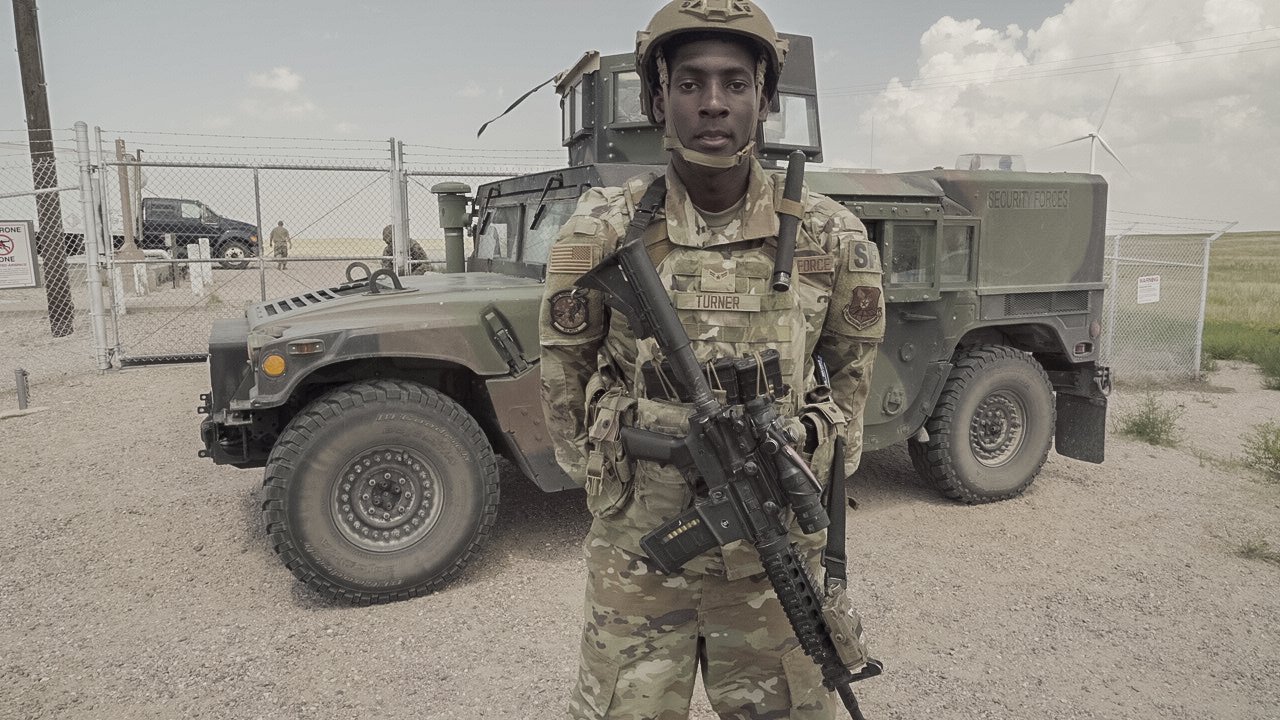
Airman 1st Class Brandon Turner guards a missile silo in Wyoming as part of an Air Force Security Forces detail. Photo by Nolan Peterson/Coffee or Die Magazine.
Twenty-year-old Airman 1st Class Brennan Hughes then leads me down a narrow ladder into the bowels of the missile silo. We step into a doughnut-shaped room that wraps around the missile tube. I observe the missile up close through cutaways in the inner wall and ask Hughes, who is not yet old enough to legally buy a beer, if he ever pauses to appreciate the awesome power of the weapon he is responsible for maintaining.
“I definitely didn’t think I was going to be here in high school,” he says. “It’s hard work, but it’s rewarding … it’s self-rewarding. You finish the job … and you just put a missile on alert. It feels good.”
Global Strike Command maintains three ICBM bases, each of which controls about 150 launch sites and 15 launch control centers. The Minuteman III launch silos are located within the states of Wyoming, Montana, North Dakota, Nebraska, and Colorado, according to a 2020 Congressional Research Service report. Despite their remoteness, the launch sites are closely monitored, and helicopter-based quick-reaction forces are always ready to respond to any incursion. Yet, apart from routine maintenance activities, no personnel are required at the silos for launch. Missile control is contained within the various launch control centers.
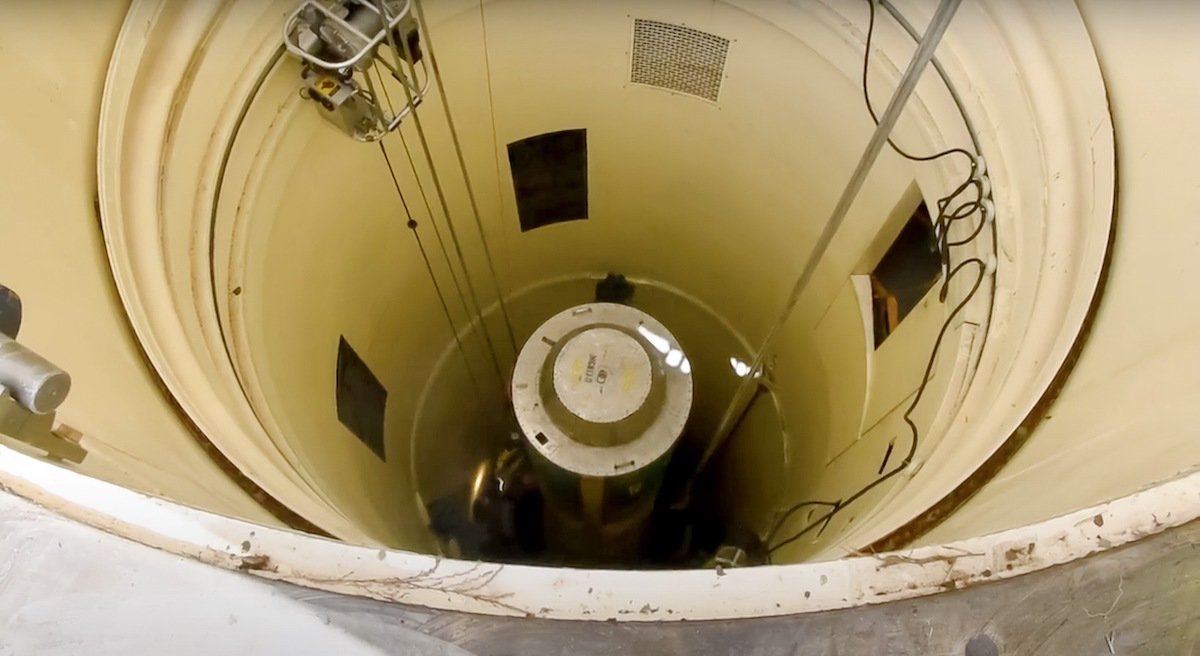
A Minuteman III ICBM undergoing maintenance inside a silo in Wyoming in 2021. Photo by Nolan Peterson/Coffee or Die Magazine.
According to the New START treaty, the US is currently limited to 400 launch-ready, land-based, nuclear-tipped ICBMs. While the Minuteman III is capable of carrying multiple nuclear warheads, the US reduced all payloads to a single warhead in 2014 to comply with that agreement. The two types of thermonuclear warheads currently slated for use in the Minuteman III each have a yield of more than 300 kilotons.
Minuteman III ICBMs are powered by solid fuel, making them more reliable and faster to launch than liquid-fueled ICBMs, such as the Titan II, which are no longer in service. Even so, the half-century-old Minuteman system is nearing the end of its operational life span. According to Lutton, modern threats have made it a “necessity” to upgrade America’s nuclear missile arsenal to the Ground-Based Strategic Deterrent, a land-based ICBM system currently under development to replace the Minuteman III.
“[Our] mission is to be so ready and so prepared that an adversary looks at [us] and goes, ‘Yeah, I don’t want any of that,’” Lutton says.

Inside the cockpit of a B-52 bomber during a training mission. Photo by Nolan Peterson/Coffee or Die Magazine.
The ‘BUFF’
About a week after visiting the Wyoming missile sites, I arrive at Barksdale Air Force Base in Louisiana to learn about another arm of America’s nuclear deterrent — the strategic bomber fleet. To this end, I’m scheduled to ride along on a B-52H bomber training sortie with the 96th Bomb Squadron.
First flown in the 1950s, the B-52 was originally designed to wage nuclear war against the Soviet Union. Although 24/7 alert status for America’s fleet of strategic bombers ended in 1968, B-52 aircrews have traditionally performed a broad portfolio of other, non-nuclear missions. This venerable airframe has played a key role in conventional conflicts spanning from Vietnam to the wars in Iraq and Afghanistan. Now, after decades of modifications and upgrades, the B-52H remains at the leading edge of America’s efforts to strategically deter contemporary, nuclear-armed adversaries.
“We’re one of the few aircraft that can do the full gamut of any mission they give us,” says Capt. Jonathan Travalio, a B-52H weapons system officer in the 96th Bomb Squadron. “One of the biggest benefits of the B-52 is that it’s a very upgradable platform. Our newest one was made in 1961, so they’re showing some age on them, but we’re able to keep them relevant now and well into the future.”

B-52H Stratofortresses from the 2nd Bomb Wing line up on the runway at Barksdale Air Force Base, Louisiana, Oct. 14, 2020. US Air Force photo by Senior Airman Tessa B. Corrick.
On Feb. 1, 2010, less than a year after its inception, Air Force Global Strike Command assumed control over America’s strategic bomber fleet from Air Combat Command. The New START treaty limits the US strategic bomber fleet to 50 aircraft. The Arms Control Association reports that, as of September 2020, the US Air Force had 48 operational bombers capable of carrying nuclear weapons. None of these aircraft are on nuclear alert status during peacetime.
In preparation for my B-52 flight, I undergo a daylong refresher course in ejection seat operations and aerospace physiology. As a former Air Force pilot, I feel like I’ve reentered my element. The day of the flight is calm and clear and I join the crew for the preflight brief. The Air Force has loaned me a flight suit, boots, and a helmet for the day. I listen intently to the aircraft commander’s briefing and then try to keep out of the way as the crew makes their final preparations (one last trip to the head is always a good idea) before loading into a small bus that drives us across the flight line to where dozens of B-52 bombers are parked.
We stop in front of our assigned aircraft, and I have a few minutes while the crew completes their preflight checks to walk around and observe this legendary bomber up close. It’s about as big as I expected, but the wingspan is surprisingly broad, and the wings are swept back at a sharp angle that resembles the sweep of a fighter jet’s delta wings. Minutes later, I take my place in a jump seat behind the two pilots and observe as they start the engines, taxi, and take off. In flight, the aircrew guides the bomber through an air refueling exercise, as well as the simulated employment of standoff weapons against a near-peer adversary.
“Each week we’ll have a different focus. […] We’re constantly training for nukes, but we also have to keep up our conventional capabilities, as well,” says one of the two pilots, who asks not to be named for this report.
“More and more our training is focused on larger-scale ground conflict in a contested environment — so not having that air superiority that we’re accustomed to, and having to work around that,” the pilot adds.
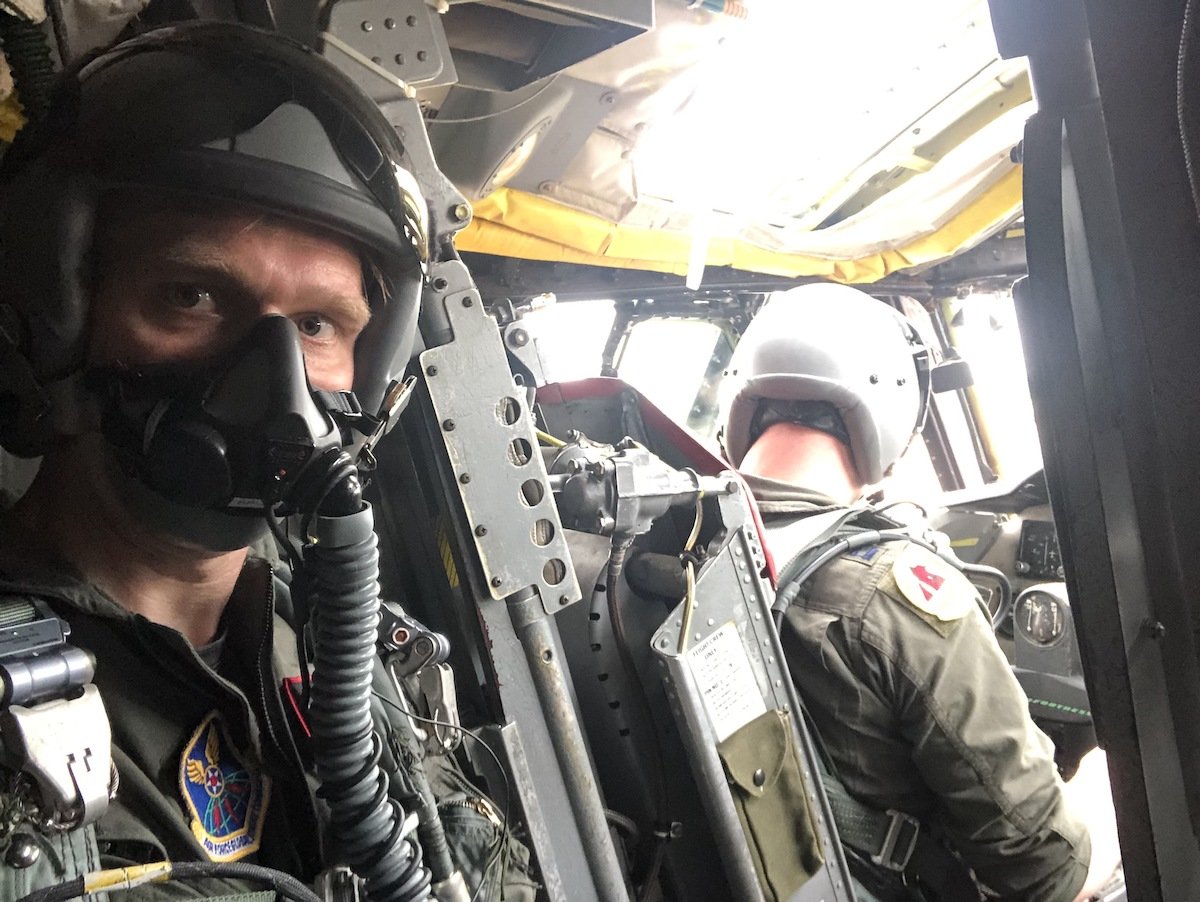
The author inside the cockpit of a B-52H bomber during a training mission. Photo by Nolan Peterson/Coffee or Die Magazine.
During the sortie I scan the cockpit and all its antiquated round dials. I reflect on the existential threats to our nation that this airframe was originally designed to confront — threats that are now back at the forefront of US defense priorities.
Reflecting a sober appreciation for the awesome responsibility of carrying nuclear weapons, Travalio, the weapons system operator, later tells me:
“That’s definitely something that everybody makes their own peace with when they get selected for this airframe. And everybody comes to terms with it in their own personal way. But the way I look at it … it’s my job to help defend the country with any means possible. So, if one day it should come to that, then I’m ready for it.”
This article first appeared in the Fall 2022 print edition of Coffee or Die Magazine as "American Nukes."
Read Next: DISPATCH: The Dramatic First Launch of America’s New Moon Rocket, Artemis 1

BRCC and Bad Moon Print Press team up for an exclusive, limited-edition T-shirt design!
BRCC partners with Team Room Design for an exclusive T-shirt release!
Thirty Seconds Out has partnered with BRCC for an exclusive shirt design invoking the God of Winter.
Lucas O'Hara of Grizzly Forge has teamed up with BRCC for a badass, exclusive Shirt Club T-shirt design featuring his most popular knife and tiomahawk.
Coffee or Die sits down with one of the graphic designers behind Black Rifle Coffee's signature look and vibe.
Biden will award the Medal of Honor to a Vietnam War Army helicopter pilot who risked his life to save a reconnaissance team from almost certain death.
Ever wonder how much Jack Mandaville would f*ck sh*t up if he went back in time? The American Revolution didn't even see him coming.
A nearly 200-year-old West Point time capsule that at first appeared to yield little more than dust contains hidden treasure, the US Military Academy said.












